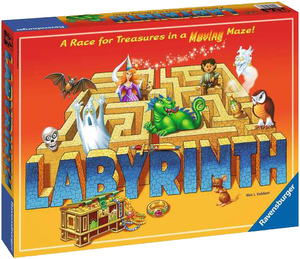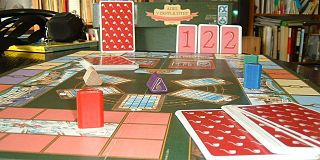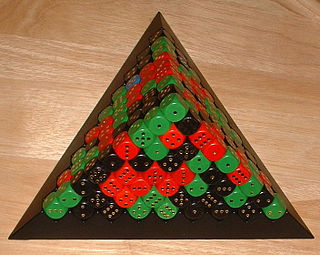
Top Secret Spies (German name: Heimlich & Co.) is a spy-themed German-style board game designed by Wolfgang Kramer and published in 1984 by Ravensburger. The game, also known as Under Cover or Detective & Co, won the Spiel des Jahres award in 1986.

Top Secret Spies (German name: Heimlich & Co.) is a spy-themed German-style board game designed by Wolfgang Kramer and published in 1984 by Ravensburger. The game, also known as Under Cover or Detective & Co, won the Spiel des Jahres award in 1986.
The object of the game is to score the most points, while not revealing which colour you are until the end. It requires good bluffing and analytical skills. 7 colours are used, and there can be up to 4 "robot" colours moving around. On their turn a player rolls a die and can move any number of pieces a total number of spaces that adds up to the number on the die. This can result in a score, and the game continues until one player reaches 129+ points. At this time all players make secret guesses as to which player is which colour (gaining +5 points at the end of the game for each correct answer). The game ends when a spy reaches 142+ points, and then a winner is determined after guess points are added.
Upon its release the game won the Spiel des Jahres award in 1986. [1] It is remembered in part as the first game to feature a score track encircling the board, now a common feature in many games, as well as the game that introduced thin wooden human-shaped gaming pieces (meeples). [2] In a 1990 interview, Kramer revealed that Heimlich & Co. was not one of his personal favourites. [3]

Scotland Yard is a board game in which a team of players controlling different detectives cooperate to track down a player controlling a criminal as they move around a board representing the streets of London. It was first published in 1983. It is named after Scotland Yard which is the headquarters of London's Metropolitan Police Service in real-life. Scotland Yard is an asymmetric board game, during which the detective players cooperatively solve a variant of the pursuit–evasion problem. The game is published by Ravensburger in most of Europe and Canada and by Milton Bradley in the United States. It received the Spiel des Jahres award in 1983-the same year that it was published.

Carrom is a tabletop game of Indian origin in which players flick discs, attempting to knock them to the corners of the board. The game is very popular in the Indian subcontinent, and is known by various names in different languages. In South Asia, many clubs and cafés hold regular tournaments. Carrom is very commonly played by families, including children, and at social functions. Different standards and rules exist in different areas. It became very popular in the United Kingdom and the Commonwealth during the early 20th century.

Torres is a German-style board game designed by Wolfgang Kramer and Michael Kiesling and published in 1999 by FX Schmid in German and by Rio Grande Games in English. The game strongly influenced Kramer and Kiesling's Mask Trilogy of games, but is not considered to be a part of the trilogy. The game has since been reprinted.

El Grande is a German-style board game for 2-5 players, designed by Wolfgang Kramer and Richard Ulrich, and published in 1995 by Hans im Glück in German, by Rio Grande Games in English, and by 999 Games in Dutch. The game board represents renaissance-era Spain where the nobility fight for control of the nine regions. El Grande was praised for its area-control mechanism, and was awarded the Spiel des Jahres prize and the Deutscher Spiele Preis in 1996. Following its release, several expansions and an alternative version were published.

Railway Rivals is a railroad-themed board game that was originally published by Rostherne Games in 1973. A German language edition was released by Bütehorn in 1979, and a mass-market edition in the UK by Games Workshop in 1985. The game involves railway building and operations.
This page lists board and card games, wargames, miniatures games, and tabletop role-playing games published in 1986. For video games, see 1986 in video gaming.

Wolfgang Kramer is a German board game designer.

Tikal is a German-style board game designed by Wolfgang Kramer and Michael Kiesling and published in 1999 by Ravensburger in German and by Rio Grande Games in English. Set in a Central American jungle, in Tikal players aim to discover artifacts, excavate, and maintain temple control to gain victory points.

Labyrinth is a board game for two to four players, published by Ravensburger in 1986.

Hare and Tortoise is a Eurogame designed by David Parlett in 1974 and first published by Intellect Games. In 1978 it was released by Ravensburger in Germany, and received generally positive reviews critically and won the 1979 Spiel des Jahres. It has since sold some 2 million units in at least ten languages. The current editions are published by Gibsons Games in the UK, Ravensburger in Germany and Rio Grande Games in the United States.

Hoity Toity is a board game created by Klaus Teuber in 1990.
Skirrid is a board game designed for 2–6 players.

Niagara is a German-style board game designed by Thomas Liesching and published in 2004 by Zoch Verlag and Rio Grande Games. In Niagara, which is set in the Niagara Falls, players collect, transport, and steal gems. Upon its release, the game won several awards, including the 2005 Spiel des Jahres.

Ingenious is the English name for Einfach Genial, a German abstract strategy board game designed by Reiner Knizia under commission from Sophisticated Games and published in 2004 by Kosmos. Across most of Europe it is titled as the local translation of Ingenious or Simply Ingenious, the notable exception being Mensa Connections in the UK.

Michael Kiesling is a German board game designer. Many of his games have been nominated for or have won the Spiel des Jahres, a German games award.
Conspiracy is a 1973 board game made by Milton Bradley. It can be played by 3 or 4 people, and the main goal is to bring a suitcase to their own headquarters through the use of spies. It has also been published as The Sigma File.
Manhattan is a board game designed by Andreas Seyfarth. In the game, players aim to construct and control skyscrapers that will award points. Manhattan received generally positive reviews and won the 1994 Spiel des Jahres award.

The Game is a dice game designed by Reinhold Wittig. It was first published in Germany in 1979, without rules and under the German name Das Spiel.

PictureBook Games: The Royal Bluff is a party video game developed by Japanese studio Grounding Inc and published by Nintendo for the Nintendo DSi's DSiWare download service. It was released on September 16, 2009, in Japan, on October 26, 2009, in North America and in the PAL regions on November 12, 2009, for 500 Nintendo Points points.

Metro is a board game by Dirk Henn, for 2 to 6 players.